|
|
DURABOOK U11
An elegant yet fully-rugged Intel Kaby Lake-powered 11.6-inch capacitive multi touch Windows tablet computer for the most demanding field deployments
(by Conrad H. Blickenstorfer; photography by Carol Cotton)
There is increasing demand for fully-rugged Windows tablets. To address that demand, on March 15, 2018, Durabook Americas, introduced the fully-rugged DURABOOK U11 tablet. Designed with DOD-level security for use in military, public safety and other demanding environments, the DURABOOK U11 is a beefed-up, tougher sister product to the company's successful DURABOOK R11. RuggedPCReview examined the DURABOOK U11 in detail and this report describes the tablet and what it can do.
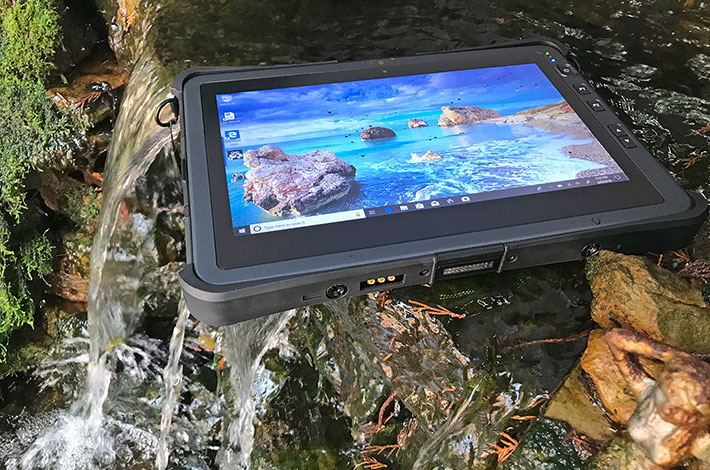
Where does the new U11 fit in? Joe Guest, President of Durabook Americas, said, "Many of our customers in markets like public safety, oil & gas, and the DOD love the form factor of our DURABOOK R11 and are now looking to move an eleven-inch tablet into more demanding and security-centric environments."
That makes sense. Over the past couple of years, the market has shown an increasing preference for larger form factor Windows tablets in the roughly 12-inch range, but this increased acceptance and broader application range for these tablets has also mandated increased ruggedness, increased security, and catering to the special needs of field personnel.
DURABOOK U11 overview and positioning
At first sight, the DURABOOK U11 looks much like the company's R11 that's been around since late 2014. However, while there is strong family resemblance, the two tablets are actually quite different. While the R11 was created as a light, high-performance large-screen tablet that was tougher than any commercial tablet, the new DURABOOK U11 was designed to be much tougher than consumer tablets, and that required a different approach.
So what was Durabook Americas' thinking process when they conceived and designed the DURABOOK U11 as a tablet that would appeal to those enterprise and industrial customers?
|
DURABOOK U11 vs R11
|
DURABOOK U11
|
DURABOOK R11
|
|
Ruggedness
|
Fully rugged
|
Fully rugged
|
|
Processors
|
Intel 7th Gen "Kaby Lake" Y-Series
|
Intel 5th Gen "Broadwell" U-Series
|
|
Thermal Design Power (TDP)
|
4.5 watts
|
15 watts
|
|
Size
|
12.5 x 8.5 x 0.94 inches
|
11.8 x 7.6 x 0.78 inches
|
|
Weight
|
3.06 lbs
|
2.65 lbs
|
|
Fan
|
No
|
Yes
|
|
Drop spec
|
6 feet
|
4 feet
|
|
Operating temperature
|
-20° to 60°F (-4° to 140°F)
|
-10° to 55°F (14° to 131°F)
|
|
Intrinsic safety
|
ANSI 12.12.01 C1D2
|
ANSI 12.12.01 C1D2
|
|
Display Program
|
11.6-inch (1,920 x 1,080)
|
11.6-inch (1,366 x 768)
|
|
Quick-release SSD
|
Yes
|
No
|
|
Hardware buttons
|
Yes
|
No
|
Overall concept — Both the DURABOOK R11 and U11 are modern, handy Windows tablets that don't weigh very much. Both have spacious 11.6-inch displays. But whereas the R11 has a fan, the U11 doesn't. That's one less potential point of failure (and makes the unit silent).
Performance — To provide high peak performance even without a fan, the U11 uses Y-Series Core processors that generate much less heat to remove than the U-Series Core processors in the R11, just 4.5 watts in the U11 versus 15 watts in the R11.
Display — Consumer tablet displays have become very good, and that meant the U11's had to be top-notch, too, perfect viewing angle and all. On top, because some customers would use their U11s outdoors all day long, the screen had to be bright enough to be viewable in daylight and even direct sunlight. So the DURABOOK U11 has a terrific outdoor-viewable 1,000 nits display and optical bonding to cut down reflection. Both units have the same size display and the same aspect ratio, but the U11 screen offers full 1920 x 1080 pixel resolution whereas the R11 default display is at 1,366 x 768 pixel.
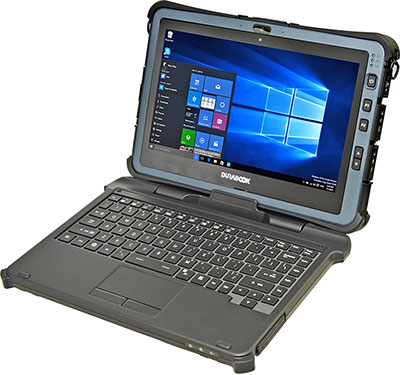 Touch screen — Almost all modern tablets use capacitive multi-touch, and the U11 does, too. It works intuitively and flawlessly. Our review unit had the optional digitizer with an active pen. While Windows 10 is more touch-friendly than earlier versions of Windows, the very precise active pen still comes in handy and we highly recommend it.
Touch screen — Almost all modern tablets use capacitive multi-touch, and the U11 does, too. It works intuitively and flawlessly. Our review unit had the optional digitizer with an active pen. While Windows 10 is more touch-friendly than earlier versions of Windows, the very precise active pen still comes in handy and we highly recommend it.
2-in-1 functionality — As tablets continue to replace desktops and laptops in many deployments, "hybrid" functionality is increasingly important. Durabook offers an excellent detachable keyboard for the U11.
Connectivity — Consumer tablets often only have the barest minimum of ports. That won't do in a full-function enterprise Windows tablet. Durabook knows that and equipped the U11 with enough to cover all the bases.
Ruggedness — The very reason the U11 exists is because it must be tough enough to survive spills and drops and other calamities that kill consumer tablets. So it must be as tough as can be, and as well sealed as can be, but without looking like a tank.
Performance — Intel has trained consumers to expect the latest chips and technology in a tablet. With a choice of three Intel Core-Y series processors and related technology, the DURABOOK U11 has all of that, too.
Security — Security is ever more important and a growing number of customers have specific security requirements for device usage. The U11 includes TPM 2.0, a M.2 solid state disk that can quickly be removed from the outside, an insertable SmartCard/CAC reader, as well as optional fingerprint scanner, contactless SmartCard/CAC reader and Intel vPro on certain chips.
The above is what Durebook Americas had to consider when creating the U11. Now let's see how it all came together.
Design, look, and feel — elegant utility
Below you can see the DURABOOK U11 from the front and all four sides. It's a clean, elegant and attractive design with a glass front, a dark-gray and black plastic and aluminum-magnesium alloy case, and protective black rubber bumpers. The bezel area around the display is wide enough to hold the tablet without inadvertently issuing a touch command, and except for the slightly protruding bumpers there is no border for fingers to bop into while operating the tablet.
The tablet is as solid as it looks. There is no flexing or twisting. The U11 has the trust-inspiring look of a reliable, well-conceived tool for the job.
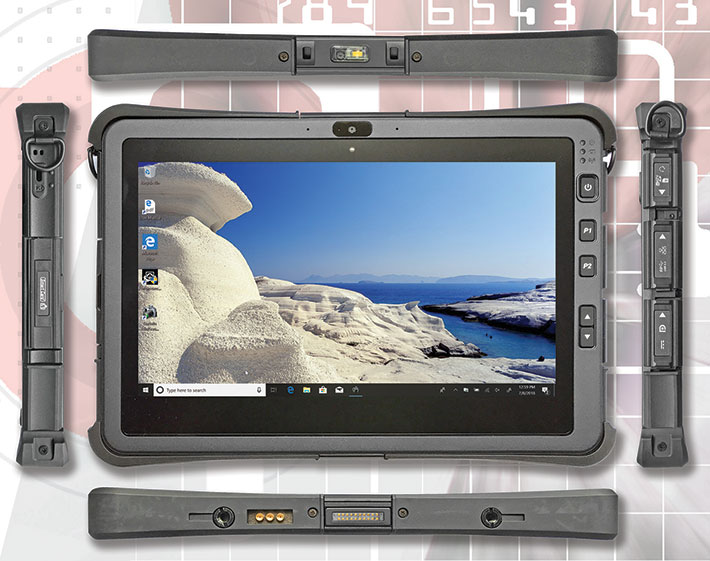
The front of the tablet shows a generous margin of flush black glass around the actual LCD. That's needed for optimal capacitive multi-touch operation. Along the right side of the tablet are five physical buttons: sleep/power, two programmable function keys, and up/down buttons that can be assigned either to brightness or volume.
The left side has a Kensington lock slot to physically secure the tablet and, in our unit, a slot to insert a SmartCard.
On the bottom is a surface-mount "Pogo" docking connector and, next to it, pass-through connectors for WLAN, GNSS and WWAN antennae. There are two metal mounting screw holes for use with the optional detachable keyboard.
Centered in the top is a configurable area that can accommodate a barcode scanner (shown), a RS232 serial port, or a USB port.
For space and sealing reasons, rugged tablets generally don't have much onboard wired connectivity, but the DURABOOK U11 does provide all the basics. The picture below shows the right side of the U11 (we removed all protective doors for this picture).

From left to right, there's the power jack, a mini DisplayPort connector, USB 3.0 Type-A, a RJ45 LAN jack, a micro SD Card slot (supporting SDHC and SDXC cards), a SIM card slot, and an audio combo jack. The SIM and SD Card openings have their separate protective cover that's screwed on.
A look inside — solid as a rock
Here at RuggedPCReview we're often asked why we take review machines apart. The answer is that ruggedness must be more than skin-deep. What it looks like inside — design, materials, manufacturing, quality — tells the real story. A truly rugged tablet must be designed rugged from the ground up, and inside out.
While from the front the U11 looks much like a consumer tablet with some extra hardware buttons and protective bumpers, on the back and inside this DURABOOK is all functionality and business. The battery, recessed into the backside of the tablet, can be replaced with a freshly charged on in seconds. Compare that with a consumer tablet battery that's inaccessible and glued in place.
The battery is part of the design and doesn't have a separate cover over it. A friction lever with a push button activator is used to securely hold the battery in place. It is unlikely that it'll ever work itself loose accidentally. A very clever design.
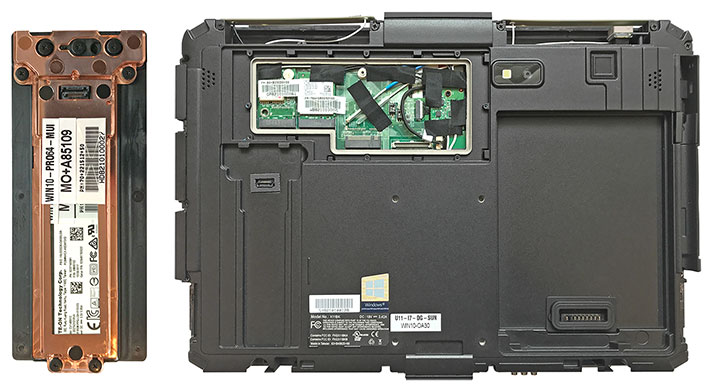
Since there is no battery compartment cover, the battery contact area has a rubber seal that presses against the aluminunm-magnesium frame to make a watertight seal. Whenever replacing the battery, make sure the seal is fully intact. The slender (3/8-inch) battery itself is a Lithium-Ion design rated at 7.6 Volt, 4.5 Ahr, for a total of 36.5 watt-hours.
In the image above, next to a look at the partially disassembled backside of the DURABOOK U11, is a magnified view of the tablet's solid state disk. The storage module is encased in a separate caddy that snaps and locks into a recessed area of the U11 housing. This allows quick removal of the disk, something that is becoming mandatory in many applications.
The U11's expansion connector area is also externally accessible. It sits underneath a metal cover with a separate rubber seal. In our review unit, the two half-size PCIe slots were occupied by an Intel Dual Band Wireless-AC 8260NGW M.2 module that also includes Bluetooth 4.2, and a uBlox NEO-M8N GNSS module. A full-size PCIe slot was unoccupied; it is generally used for a mobile broadband module, and there are wires to connect to the onboard antenna.
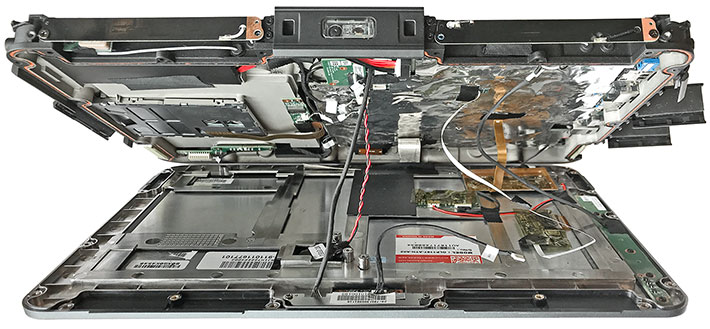
In terms of construction, the DURABOOK U1 employs a very sturdy aluminum-magnesium rear that serves as a chassis for most of the electronics, and a polymer plastic front. The two halves are secured together with about two dozen Philips head screws of various lengths. First remove the four protective corner bumpers that are really more than just corner guards; they also cover much of the sides of the tablet.
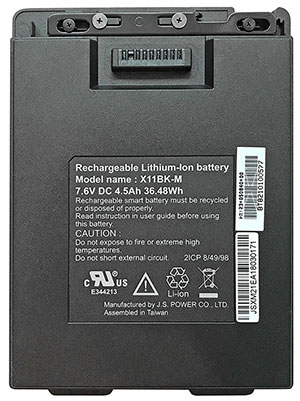 The sealing between the two halves is a tongue-and-groove design, with an orange sealing ring firmly sitting in the groove along the perimeter of the back part of the housing. The sealing between the two halves is a tongue-and-groove design, with an orange sealing ring firmly sitting in the groove along the perimeter of the back part of the housing.
The DURABOOK U11 is a fanless design, so there is no need to seal liquids entering through exhaust vents. The tablet's various wireless antennae, however, are placed outside of the sealed part of the housing for best possible performance. That means there are small holes with grommets for all the wires going to the antennae.
There are over half a dozen wires and ribbons between the two halves, connecting various boards and components. Since some of the connections are delicate and not easily accessible, we decided to just take a peek inside and not disassemble the tablet completely.
What's often surprising when looking inside a rugged tablet is their great complexity compared to, say, an iPad. That's because Windows tablets are complete PCs with all of their modules and all of their settings and configuration options.
The U11 is no different. And, as a result, tablets like the U11 can be configured for the job at hand. Something that can't be said of consumer tablets. That said, we're not generally fans of too many wires, 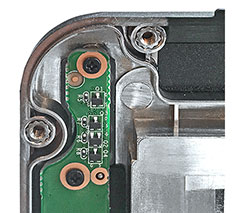 especially between halves of tablet housings, because each tiny connector is a potential source of failure. especially between halves of tablet housings, because each tiny connector is a potential source of failure.
To the left and below a detail that shows what is involved in sealing such a complex piece of electronics to the elements, and to liquids in particular. The U11 is IP65 sealed, where the "5" means it can handle water jets from all directions without leaking. That requires some pretty good seals.
But that's not all there is to sealing. If you use a metal case, as the U11 does, internal antennae will not work well because the metal shields them. For optimal reception, antennae must be outside the metal case. Durabook Americas did that by placing all antennae in cutouts along the perimeter of the housing.
This meant the seal had to meander around those cutouts. While they did that, they decided the placement of the screws that keep the two halves of the housing together should also be outside the seal. Good logic, difficult to manufacture, but Durabook Americas did it.

Performance — turbo-4s instead of V8s
Selecting the right processor for a tablet is never easy, not for the designers and not for the customers. A high-end processor can cost 10-15 times as much as a low-end one, and that has a substantial impact on the price of the device. More performance generally also means more weight, because a powerful processor generally needs more cooling and a bigger battery.
|
Available DURABOOK U11 CPUs (all specs)
|
Intel Core i7
|
Intel Core i5
|
Intel Core m
|
|
Model
|
7Y75
|
7Y54
|
7Y30
|
|
Cores/Threads
|
2/4
|
2/4
|
2/4
|
|
Base Clock Speed
|
1.30 GHz
|
1.20 GHz
|
1.00 GHz
|
|
Turbo Speed
|
3.60 GHz
|
3.20 GHz
|
2.60 GHz
|
|
Thermal Design Power (TDP)
|
4.5 watts
|
4.5 watts
|
4.5 watts
|
|
Smart Cache
|
4MB
|
4MB
|
4MB
|
|
Integrated graphics
|
HD Graphics 615
|
HD Graphics 615
|
HD Graphics 615
|
|
Graphics base speed
|
300 MHz
|
300 MHz
|
300 MHz
|
|
Graphics max speed
|
1.05 GHz
|
0.95 GHz
|
0.90 GHz
|
|
Intel Stable Image Platform Program
|
Yes
|
No
|
No
|
|
Intel TSX-NI
|
Yes
|
No
|
No
|
|
Intel Trusted Execution
|
Yes
|
No
|
No
|
|
Intel vPro
|
Yes
|
No
|
No
|
For the DURABOOK U11, Durabook Americas chose a trio of Intel 7th generation "Kaby Lake" processors, but they are from the Y-Series and not the more common U-Series. What's the difference? Here's the story:
Confronted with the need for processors that could run Windows on slender, lightweight tablets without fans and big batteries, Intel pursued two different strategies. One was very basic chips that use very little power and are generally sold under the Atom brand. Atom chips work just fine for many, but not all, applications. If more performance is needed, Intel's second strategy was to pack most of the power of its high-end U-Series mobile processors into chips that dissipate much less heat.
How could this work? By running those chips at a much lower default clock speed, but with the ability to run at greatly higher speed for a limited period of time. But don't U-Series chips already do that with their "turbo" mode? Yes, U-Series processors also have a default clock speed but can run at higher clock speeds for a limited time. The difference is that Y-Series chips are a significantly more extreme implementation of this concept.
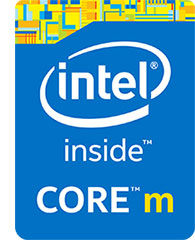 Whereas a U-Series processor might run at a default clock speed of 3GHz and can reach turbo speeds of 3.6GHz, a Y-Series chip might run at a much lower default clock speed of just 1.3GHz, but also reach the same high 3.6Ghz in turbo mode. The lower default clock speeds with only limited bursts at high clock speeds mean that Y-Series processors have a much lower TDP (Thermal Design Power) than U-Series chips. TDP is an Intel measure for how much heat a device running a certain processor must be capable of removing. The three available Y-Series chips have TDPs of just 4.5 watts, less than a third that of common U-Series processors. No fan is needed, and power consumption is very low. Whereas a U-Series processor might run at a default clock speed of 3GHz and can reach turbo speeds of 3.6GHz, a Y-Series chip might run at a much lower default clock speed of just 1.3GHz, but also reach the same high 3.6Ghz in turbo mode. The lower default clock speeds with only limited bursts at high clock speeds mean that Y-Series processors have a much lower TDP (Thermal Design Power) than U-Series chips. TDP is an Intel measure for how much heat a device running a certain processor must be capable of removing. The three available Y-Series chips have TDPs of just 4.5 watts, less than a third that of common U-Series processors. No fan is needed, and power consumption is very low.
An automotive analogy would be the difference between a big V8 engine and a small turbocharged 4-cylinder motor. The big V8 has lots of power but isn't very energy-efficient. The small turbo motor is much more efficient just tooling around town, but they can also generate impressive performance when the turbo kicks in. Likewise, a Y-Series chip provides enough performance for most tasks at its low default clock speed, but when brief bursts of power are needed, it can do that, too.
To see what kind of performance the DURABOOK U11 provides with its dual-core Y-Series Core i7 processor, we ran our standard benchmark suite, Passmark Software's PerformanceTest 6.1, that runs about 30 tests covering CPU, 2D graphics, 3D graphics, memory, and disk and then computes scores for each category and an overall PassMark score. We also ran our second benchmark suite, CrystalMark, for confirmation and additional information. For comparison and to provide an idea where the DURABOOK U11 stands, we included benchmark results for the DURABOOK R11 and for three competitors in the 11.6-inch rugged tablet class, the Dell rugged Tablet, the DT Research 311H, and the Getac F110.
The results are as follows:
|
DURABOOK U11 Benchmarks and Comparisons
|
|
PERFORMANCE COMPARISON
|
Durabook
|
Durabook
|
Dell
|
DT Research
|
Getac
|
|
Model
|
U11
|
R11
|
Rugged Tablet
|
311H
|
F110
|
|
Device type
|
Rugged tablet
|
Rugged tablet
|
Rugged tablet
|
Rugged tablet
|
Rugged tablet
|
|
Year tested
|
2018
|
2016
|
2017
|
2016
|
2015
|
|
Screen size
|
11.6-inch
|
11.6-inch
|
11.6-inch
|
11.6-inch
|
11.6-inch
|
|
Processor Type: Intel
|
Core
|
Core
|
Core
|
Core
|
Core
|
|
Processor Model
|
i7-7Y75
|
i5-5200U
|
m-5Y71
|
i7-5500U
|
i7-5500U
|
|
Processor Code
|
Kaby Lake
|
Broadwell
|
Broadwell-M
|
Broadwell
|
Broadwell
|
|
CPU Speed
|
1.30 GHz
|
2.20 GHz
|
1.20 GHz
|
2.40 GHz
|
2.40 GHz
|
|
CPU Speed Turbo
|
3.60 GHz
|
2.70 GHz
|
2.90 GHz
|
3.00 GHz
|
3.00 GHz
|
|
Thermal Design Power (TDP)
|
4.5 watts
|
15 watts
|
4.5 watts
|
15 watts
|
15 watts
|
|
CPU Mark
|
3,775.6
|
3,545.6
|
2,683.8
|
4,135.1
|
3,864.1
|
|
2D Graphics Mark
|
280.1
|
423.7
|
370.6
|
468.6
|
514.7
|
|
Memory Mark
|
1,720.6
|
1,052.3
|
952.2
|
1,192.3
|
1,215.6
|
|
Disk Mark
|
3,997.0
|
3,901.1
|
3,595.2
|
3,773.2
|
3,790.4
|
|
3D Graphics Mark
|
367.0
|
337.1
|
265.6
|
545.2
|
399.1
|
|
Overall PassMark
|
2,211.7
|
2,026.7
|
1,694.0
|
2,216.8
|
2,140.1
|
|
ALU
|
39,309
|
41,063
|
32,389
|
47,947
|
45,208
|
|
FPU
|
32,013
|
40,731
|
26,550
|
43,796
|
41,610
|
|
MEM
|
34,472
|
29,692
|
29,070
|
49,128
|
30,389
|
|
HDD
|
39,733
|
39,300
|
38,565
|
40,137
|
41,405
|
|
GDI
|
10,797
|
13,452
|
11,673
|
15,739
|
16,218
|
|
D2D
|
4,431
|
5,710
|
4,373
|
7,101
|
6,438
|
|
OGL
|
7,464
|
11,210
|
6,843
|
11,774
|
10,5432
|
|
Overall CrystalMark
|
168,219
|
181,158
|
149,463
|
215,622
|
191,811
|
When looking at the overall results, the first thing you'll notice is that at least in benchmark testing the U11 is easily a match for tablets with standard U-Series processors. Despite its much lower thermal design power of 4.5 watts, the U11 blasted through the tests at roughly the same pace as 15 watt systems.
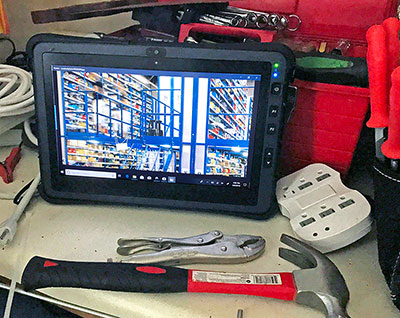 Comparing the DURABOOK U11 and the last DURABOOK R11 tablet we tested shows that they perform at roughly the same level, with the U11 edging ahead in multiprocessor testing mostly thanks to its quicker memory (note, though, that the R11 is also available with a more powerful i7-5500U chip whereas the i7-7Y75 in our test U11 is the top offering).
Comparing the DURABOOK U11 and the last DURABOOK R11 tablet we tested shows that they perform at roughly the same level, with the U11 edging ahead in multiprocessor testing mostly thanks to its quicker memory (note, though, that the R11 is also available with a more powerful i7-5500U chip whereas the i7-7Y75 in our test U11 is the top offering).
Judging by our past experience with Y-Series versus U-Series Intel processors, the U-Series offers more predictable performance. That's because they are built to operate at their higher default clock speed and generally can run at maximum turbo boost for extended periods.
Y-Series chips default to a much lower clock speed, and it is never totally clear what programs may coax them to increase clock speed, and what temperature constraints they may have that allows them to reach their very high maximum turbo speeds. On the plus side, there's the lighter weight thanks to a smaller battery and the absence of a fan.
In our day-to-day testing, the DURABOOK U11 felt quick and responsive, and was up to any workload we threw at it.
Battery life
Rugged laptops and tablets used to have very short battery life, which greatly limited the usefulness of mobile technology in the field. Battery technology has improved substantially, but not as quickly as processor and storage technology. As a result, it's still often a trade-off between size, weight, cost and battery life.
In 2010, the iPad's 10 hour battery life redefined expectations of how long a tablet should last on a charge. 10 hours is a full shift plus another 25% to cover eventualities. The DURABOOK U11's spec sheet claims "up to 8 hours." Given the U11's fairly small battery, can the tablet live up to that claim?
|
DURABOOK U11 Power Draws (at idle)
|
|
Backlight level
|
Darkest
|
Recommended
|
Brightest
|
|
Max Battery
|
4.4 watts (8.1 hrs)
|
5.7 watts (6.2 hrs)
|
7.8 watts (4.6 hrs)
|
|
Max Performance
|
4.6 watts (7.7 hrs)
|
6.6 watts (5.4 hrs)
|
9.5 watts (3.8 hrs)
|
We used PassMark's BatteryMon to find out. With the new Windows 10 slider moved all the way to "Best battery life" mode, and the new 5-way screen brightness toggle set to "darkest," we saw a minimum of 4.4 watts. With the backlight set to "recommended," it was 5.7 watts, and with the backlight at "brightest" about 7.8 watts. Dividing the full available 35.6 watt-hours of a fully charged battery by the lowest observed battery draw of 4.4 watts would indicate a theoretical battery life of 8.1 hours.
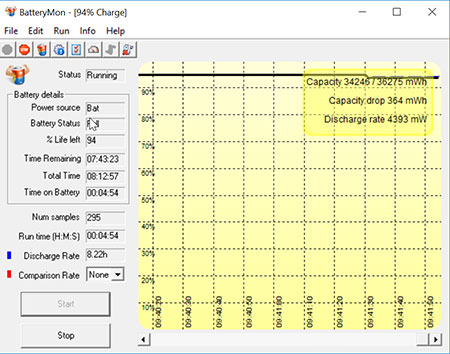 Putting the Windows 10 slider to "Best performance" and toggling the backlight to "darkest," power draw was 4.6 watts, just a tad higher than in battery conservation mode. With the backlight set to the "recommended" level, it was 6.6 watts, and with the backlight at "brightest" 9.5 watts. This means that in "Best performance" mode and backlight as bright as Windows sets it, battery life drops under four hours. Putting the Windows 10 slider to "Best performance" and toggling the backlight to "darkest," power draw was 4.6 watts, just a tad higher than in battery conservation mode. With the backlight set to the "recommended" level, it was 6.6 watts, and with the backlight at "brightest" 9.5 watts. This means that in "Best performance" mode and backlight as bright as Windows sets it, battery life drops under four hours.
Bottomline: the DURABOOK U11 can last eight hours on a charge, just as the company claims. But using the tablet in "best performance" mode and with screen brightness cranked all the way up — and the U11 has a very bright screen — the small battery drains quickly. Which is why the U11 has a bridge battery that allows hot-swapping (within five minutes) to a fully charged replacement battery.
There usual caveat: benchmark power drawdown simply measures power draw of the device idling along. In real life use in the field, the tablet may go from periods of maximum load to going to sleep. Actual battery life can therefore vary dramatically.
Excellent, spacious display
With a diagonal screen size of 11.6 inches, the U11 offers a generous amount of display real estate — almost a third more than that of a classic iPad, and almost three times as much as a typical 7-inch tablet. For a Windows 10 tablet suitable size is important, and especially so when wearing gloves or using apps with small controls. The FHD 1920 x 1080 pixel resolution works well for this size display. The screen's 10-point capacitive multi-touch works fluidly and effortlessly, though we still appreciate the optional active digitizer for when you need more precision than a finger touch provides.
Unlike the R11 which comes in a standard and a sunlight-readable version, all U11 tablets come with a sunlight-readable display that uses optical bonding to reduce internal reflectivity and increase contrast, and a stronger 1,000 nits backlight. Any strong backlight, of course, draws a lot of power when fully cranked up, and so the U11 uses its light sensor to automatically adjust screen brightness, with settings configurable via a brightness level setup panel.
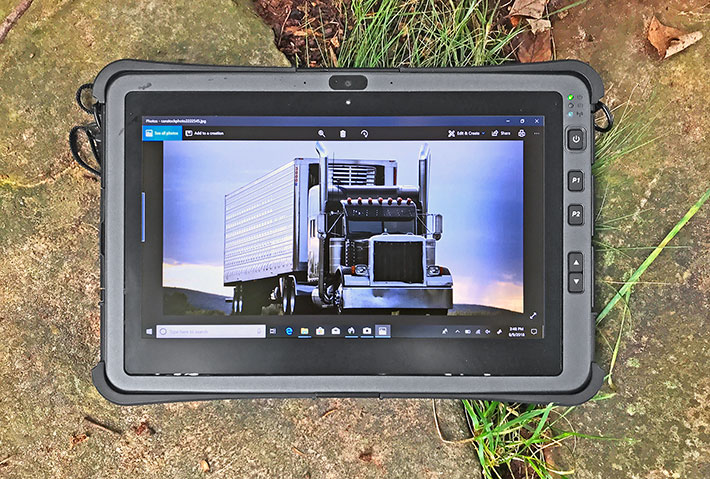
To demonstrate how it works in practice, we did a series of outdoor comparison pictures with a second gen Apple iPad Pro 12.9 tablet (which has a very good screen said to reach up to 600 nits) we use around the RuggedPCReview office.
The first picture shows the two machines outdoors on a bright and sunny East Tennessee early afternoon in mid August. Both display backlights were cranked up to maximum brightness, and both remain very readable. The DURABOOK display, though, is somewhat brighter but a bit less contrasty. The glossy capacitive touch surface of the iPad shows mild reflections.
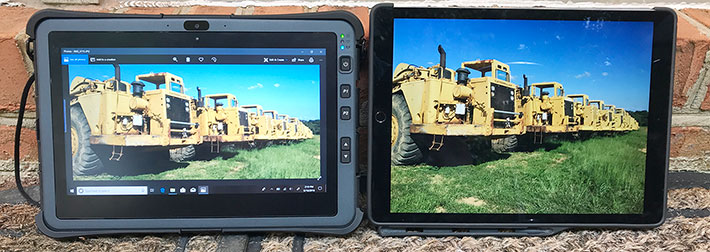
The second picture below shows the tablets from an angle. Both tablets have almost perfect viewing angles, so there are no color or contrast shifts. What does become clear is how each tablet handles reflections. The iPad's glossy screen mirrors reflections whereas the U11's semi-matte screen protector shows no reflections but slightly diffuses the light instead.
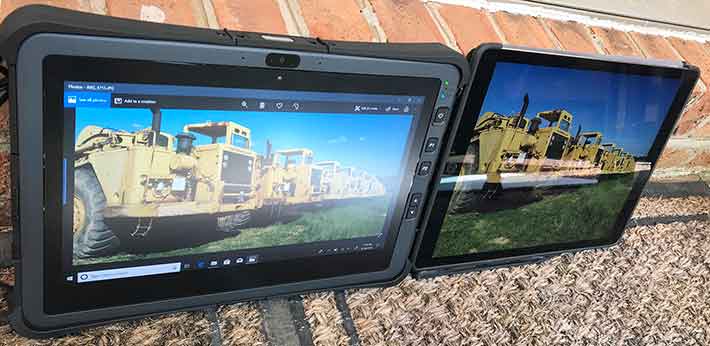
The final set of comparison pictures shows the two tablets at extreme angles. We consider perfect viewing angles to be very important in tablets, and both tablets excel in that area. The DURABOOK U11, again, looks brighter than the iPad Pro, and reflections are controlled better.

Overall, unlike the DURABOOK R11 where we noticed reflection issues that could distract in high-contrast environments, the U11's semi-matte screen surface diffuses instead. The U11 screen is very bright, has good contrast, and remains viewable from any angle, without the dreaded color shifting of lesser displays. This is about as good as it gets with current display technologies.
Capacitive multi-touch
As mentioned in the introduction, the DURABOOK U11 comes with capacitive multi-touch. This means that a generation of users that expects the effortless tapping, panning, pinching and zooming they're used to from their smartphones and consumer tablets will find just that on the U11. The display surface has a little bit more stiction than that of, for example, an iPad, but the difference is not large enough to matter.
That said, always keep in mind that Microsoft Windows Tablet PCs were originally designed to work best with an active pen that enabled "hovering" over selections, with the digitizer sensing the tip of the pen without the user actually touching the surface.
Capacitive multi touch has been a rough ride for Windows.
Before Windows 10, all those tiny check boxes and scrollers and pull-downs that were designed for use with a mouse made operation via touch alone quite frustrating. Windows 10 had made steady improvements in touch friendliness, but still remains a work in progress. For that reason, we greatly recommend the active pen option that Durabook Americas offers for the U11. It's a 5-inch Wacom-style pen that does not need a battery.

Windows-based tablets were late in adopting capacitive touch because the technology initially didn't work with gloves on or when things got wet. I say "initially" because capacitive touch technology has advanced to a point where some implementations do work with gloves up to a certain thickness, and they can also be made to work in the rain.
 On the DURABOOK U11, users can select from three touch screen settings on the included QuickMenu utility: finger/water, glove, and stylus (see image to the right). Finger/water is the default, "glove" reconfigures sensitivity to allow use with certain gloves, and "stylus" optimizes operation for the pen by ignoring unwanted finger touches. This goes a long way toward making capacitive multi touch work on a rugged Windows tablet. On the DURABOOK U11, users can select from three touch screen settings on the included QuickMenu utility: finger/water, glove, and stylus (see image to the right). Finger/water is the default, "glove" reconfigures sensitivity to allow use with certain gloves, and "stylus" optimizes operation for the pen by ignoring unwanted finger touches. This goes a long way toward making capacitive multi touch work on a rugged Windows tablet.
Dual cameras
The DURABOOK U11 has front and rear cameras, as is standard on most modern tablets. On the front is a 2-megapixel webcam. The rear camera is for picture taking and documentation. It has an 8-megapixel imager, and the pictures we took came out in 4:3 aspect ratio 3,264 x 2,448 pixel resolution, exactly 8-megapixel. We used the cameras on our review unit via the standard Windows 10 Camera application. Image settings allowed selecting resolutions ranging from 320 x 240 up to full 8mp for the documentation camera, with the same menu being used for the webcam. Both cameras can be used for stills as well as for video.
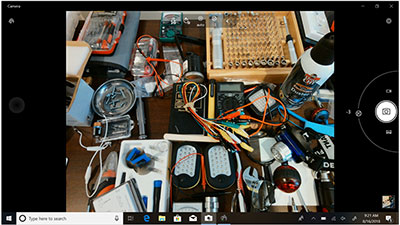 As we've repeatedly mentioned over the years, our experience with cameras integrated into rugged vertical market handhelds and tablets has generally been underwhelming, with most lagging well behind what's available in dedicated point & shoots and consumer smartphones. The situation is getting better, probably in part due to pressure from customers who by now are used to consumer smartphones and tablets equipped with very good cameras. We were pleased to find that the rear-facing documentation camera of the U11 is up to the task. After a bit of practice, the test pictures we took with the device were good enough for most field documentation tasks. As we've repeatedly mentioned over the years, our experience with cameras integrated into rugged vertical market handhelds and tablets has generally been underwhelming, with most lagging well behind what's available in dedicated point & shoots and consumer smartphones. The situation is getting better, probably in part due to pressure from customers who by now are used to consumer smartphones and tablets equipped with very good cameras. We were pleased to find that the rear-facing documentation camera of the U11 is up to the task. After a bit of practice, the test pictures we took with the device were good enough for most field documentation tasks.
The screen snap to the right shows what the camera app looks like in picture-taking mode.
The user interface is attractive and logical. In picture taking mode, you can toggle between still and video mode, turn geo-tagging on and off, set the flash mode, and select either the front or the rear camera. The settings mode is limited to image resolution and storage location.
The pictures below were shot with the DURABOOK U11 in its highest resolution mode. Click on the image to bring up a full-size version.

The U11 documentation camera is capable of taking decent pictures than are generally good enough for job documentation purpose. There is good sharpness and image detail, and little of the massive compression that often renders pictures from such integrated cameras useless due to artifacting. Patience is needed at times, as the camera takes a bit of time focus, so there's some shutter lag.
Video is better than what we've seen from cameras integrated into rugged devices even two or three years ago. The camera generally doesn't fall behind and the maximum 1920 x 1080 recording format remains useful, even at just 30 frames per second. All that said, today's smartphones have completely spoiled consumers with their superb cameras and sophisticated imaging apps.
Note that camera applications that come with mobile operating systems are often replaced with third party software optimized for certain imaging tasks, or developers and systems integrators include camera and video functionality directly into custom software.
Ruggedness — impressive
Durabook Americas' idea with the U11 was to provide customers a more rugged alternative to the existing DURABOOK R11. The goal was to make that happen without adding undue bulk and weight. As is, the much stronger U11 is a little thicker (0.94 vs 0.78 inches), a little heavier (3.06 vs 2.65 lbs.), and it has a noticeably smaller battery (36.5 vs 45.8 watt-hours). So extra ruggedness does come at a price. How much tougher is the U11 than the R11?
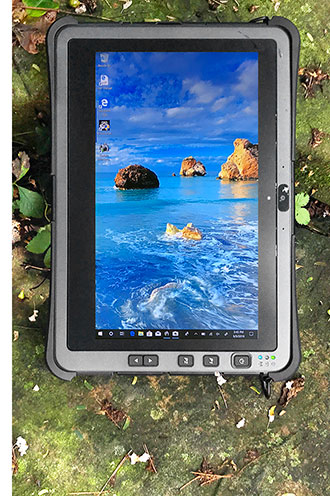 For drops, testing is conducted in modified accordance with the procedures described in MIL-STD-810G, Method 516.6, Procedure IV. Drops are from a height of 48 inches onto 2-inch plywood over concrete, with the unit powered on. Here, the U11 can handle repeated drops from six feet versus four feet for the R11. Being able to survive four-foot drops is important because that is roughly the height the tablet would fall if it slipped out of the hands of someone operating it in a standing position. Boosting that to six feet adds a potentially crucial margin and a lot of peace of mind. For drops, testing is conducted in modified accordance with the procedures described in MIL-STD-810G, Method 516.6, Procedure IV. Drops are from a height of 48 inches onto 2-inch plywood over concrete, with the unit powered on. Here, the U11 can handle repeated drops from six feet versus four feet for the R11. Being able to survive four-foot drops is important because that is roughly the height the tablet would fall if it slipped out of the hands of someone operating it in a standing position. Boosting that to six feet adds a potentially crucial margin and a lot of peace of mind.
Durabook Americas also states shock and vibration resistance in testing similar to MIL-STD-810G, Method 514.6, Procedure I, Category 24, Fig 514.6E-1 which vibrates the unit while it is powered on at prescribed frequencies for an hour per axis. This test does not simulate an application environment, but rather suggests that a device that can pass that test will survive in the field. That's perhaps a bit vague and difficult to comprehend, but that's the supplied data.
On the sealing front, the U11 is at the same IP65-level of ingress protection as the R11. The "6" means complete protection against dust, and the "5" means protection against low pressure water jets from all directions. What that means, is that the U11 can handle any degree of rain, but it shouldn't be hosed down with a pressure washer or submerged into water.
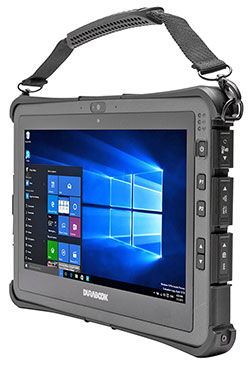 The operating temperature range is given as -4 to 140 degrees Fahrenheit (-20 to 60 centigrade). That's wider on both the high and the low end than the R11, and it is good enough for virtually all conceivable operating environments, including commercial freezers. The operating temperature range is given as -4 to 140 degrees Fahrenheit (-20 to 60 centigrade). That's wider on both the high and the low end than the R11, and it is good enough for virtually all conceivable operating environments, including commercial freezers.
Do note that Twinhead, Durabook Americas' corporate mothership in Taiwan, has decades worth of experience making all sorts of rugged computers. Twinhead is who made all those rugged and ultra-rugged Itronix notebooks, and Twinhead is a major rugged equipment OEM to a lot of system integrators and resellers around the globe. They absolutely know what they're doing.
Apart from the given specs, our detailed examination of the U11 revealed an exceptionally sturdy design and construction. The very strong and rigid magnesium-aluminum backside/chassis keeps the unit from flexing, which guards against display breakage and eliminates most of the potential trouble spots in lesser units. Further protection is provided by the extremely effective and easily replaceable corner/side screw-on bumpers.
IP65 sealing against the elements is sufficient, especially with the clever glide/lock design of the U11's protective port covers (which, of course, must be firmly in place and all seals must be undamaged in order to provide that protection).
And also keep in mind that some parts of the tablet are technically outside the sealed areas (like the antennae), so liquids can get in there. Which means that after heavy exposure those areas should be examined and dried out.
But what about the expansive glass surface? It's chemically hardened to a surface hardness of 7H, which is harder than regular window glass or a knife blade (those are about 5.5H), harder than pumice (6) and harder even than a steel file (6.5H). So it's not likely to get scratched.
Summary: The DURABOOK U11
With smartphones getting ever larger, tablet screens are growing, too. 11.6 inches seems a sweet spot, not too small and not too large. In that class, Durabook Americas scored with their DURABOOK R11. Now they added the DURABOOK U11, an even more rugged tablet suitable for the toughest jobs.
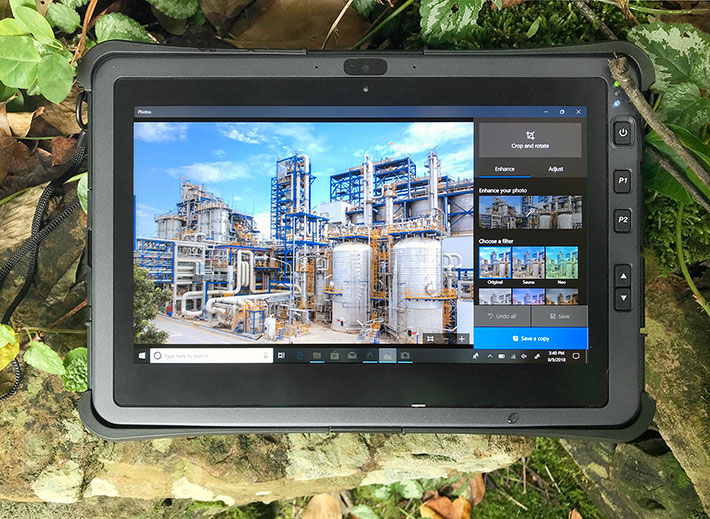
Seeking to keep the tablet as light and handy as possible and without giving up performance or battery life, Durabook Americas opted for ultra-efficient Intel Core-Y Series processors to match class-expected speed and lasting a full shift.
The U11 has a satisfyingly large 11.6-inch display with 1920 x 1080 pixel wide-format resolution that's fully outdoor-viewable thanks to a strong backlight that provides 1000 nits luminance. The capacitive multi-touch screen is quick and responsive and has settings for wetness, gloves, and stylus. An active (batteryless) pen option is for those who like to draw or annotate, or need extra precision.
The DURABOOK U11 combines a sleek, elegant design and manageable weight of just over three pounds with remarkable ruggedness. Thanks to a magnesium-aluminum alloy build and well designed protected bumpers and port covers, the DURABOOK U11 is fully dustproof and can easily handle any amount of rain. It also can be used in an exceptionally wide temperature range.
Contemporary security requirements are with addressed both in software (TPM 2.0, Windows, BIOS) and hardware (quick-release SSD, stealth/night vision modes, optional Intel vPro, fingerprint scanner, contactless SmartCard/CAC, etc.)
Overall, the fanless DURABOOK U11 addresses many of the special requirements of markets such as public safety, oil & gas, the military, and any others that require a light, handy and exceptionally configurable Windows tablet with enough performance to tackle any job in the field.
– -- Conrad H. Blickenstorfer, August 2018
|
DURABOOK U11 Specifications
|
| Status |
Added 03/2018, full review 08/2018
|
| Product type |
Fully-rugged tablet computer
|
| Processor
|
Intel Core i7-7Y75, 4MB cache, 1.3GHz/3.60GHz [tested]
Intel Core i5-7Y54, 4MB cache, 1.2GHz/3.20GHz
Intel Core m3-7Y30, 4MB cache, 1.0GHz/2.60GHz
|
| CPU Thermal Design Power
|
All 4.5 watts
|
| OS
|
Windows 10 Professional |
| Graphics Controller/Chipset
|
Intel HD Graphics 615
|
| Memory
|
Onboard 4GB/8GB/16GB LPDDR3
|
| Display type
|
TFT LCD with AG/AR film, optional sunlight-readable 1,000 nits display
|
| Display size and resolution
|
11.6" 1920 x 1080 pixel (190 ppi)
|
| Digitizer/Pens
|
Capacitive multi-touch, glove-capable, optional digitizer pen
|
| Keyboard
|
Onscreen keyboard, optional detachable kbd with 2 USB ports
|
| Storage
|
128GB to 1TB M.2 SSD or 256GB to 512GB OPAL 2.0 SSD |
| Multimedia Pocket
|
NA |
| Slots
|
1 x micro-SDXC, 1 x SIM card, optional expansion modules (PCMCIA type II OR ExpressCard 54 OR Contactless SmartCard CAC Reader)
|
| Housing
|
Aluminum-magnesium chassis |
| Temperature
|
-4° to 140°F (-20° to 60°F), down to -35F (-37C) AC mode with wide-temp SSD |
| Humidity
|
MIL-STD-810G 507.6 |
| Vibration
|
MIL-STD-810G 514.6 procedure I cat. 24, fig. 514.6E-1, unit operating |
| Enclosure Class
|
IP65 |
| EMI
|
MIL-STD-461G |
| Shock: Transit Drop
|
MIL-STD-810G 516.6 procedure IV (modified): 6 feet with unit operating |
| Intrinsic safety
|
Class I, Division 2, Groups A, B, C, D, T Code T5 |
| Certifications
|
US: FCC, FCC ID, UL
EU : CE, CB, CE |
| Size (inches)
|
12.5 x 8.5 x 0.94 inches (318 x 216 x 24 mm) |
| Weight
|
3.06 lbs. (1.39 kg.)
|
| Power
|
7.6 Volt, 4,800mAH, 36.5 watt-hour Li-Polymer ("8 hrs"), bridge battery |
| Camera
|
2.0mp front-facing, optional 8mp rear-facing auto-focus with flash and geo-tagging |
| Wireless
|
Intel Wireless AC9260 802.11ac WiFi with Bluetooth 5.0; optional: 4G LTE-Advanced WWAN, dedicated GPS, 1D/2D scanner
|
| Sensors
|
Ambient light, 9-axis motion
|
| Security
|
Kensington Lock, TPM 2.0, user removable SSD, stealth/night vision modes; optional Intel vPro, fingerprint scanner, contactless SmartCard/CAC
|
| Interface
|
1 x USB 3.0, 1 x RJ45 LAN, 1 x miniDP, 1 x RS232 OR 1 x USB 2.0 OR barcode scanner, headphone/microphone, 3 x external RF antenna connectors (WWAN, WLAN, GPS)
|
Price
|
Inquire
|
| Website
|
Durabook U11 |
| Brochure
|
 Durabook U11 (pdf) Durabook U11 (pdf)
|
| Warranty
|
3 years (includes accidental damage)
|
| Contact
|
Durabook Americas, https://www.durabookamericas.com, 1-800-995-8946.
|
|
|






